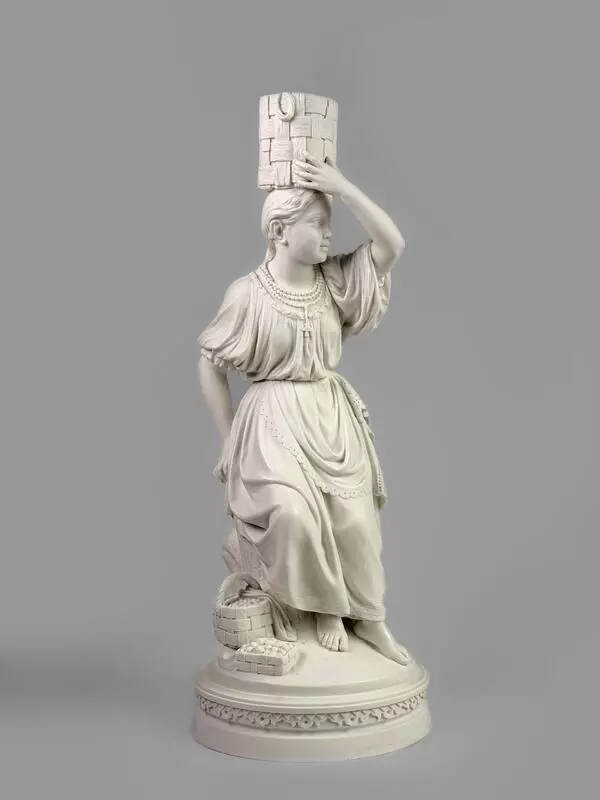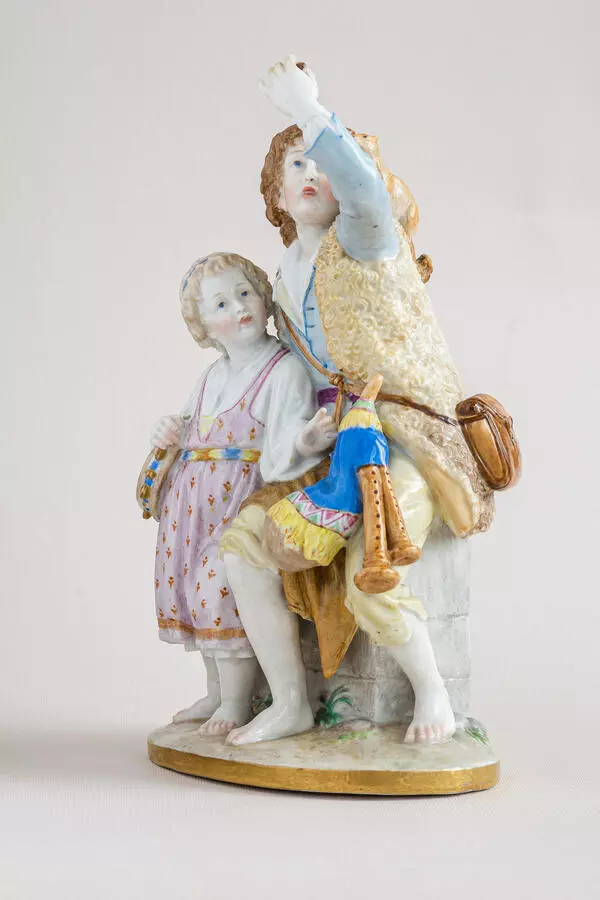The author of this work is August Spiess, a graduate of the Berlin Academy of Fine Arts. In 1848, he came to Russia to participate in the decoration of the halls of the Winter Palace after a fire had taken place there. Working as a sculptor’s assistant in the Palace, the artist became closely acquainted with the tastes of the court. In 1849, Spiess entered the Imperial Porcelain Factory as a sculptor and four years later became a chief sculptor — the model master.
The main customer of his elaborate figurines was Empress Maria Alexandrovna, the wife of Alexander II. Spiess understood very well her preferences and created artworks to her taste. Only by Christmas 1864, the Empress personally received 119 figurines.
In this sculpture, Spiess depicted Diana, the virgin goddess of the hunt, the daughter of the god of thunder Jupiter (Zeus) and the titanide Latona (Leto). Diana was also called Triformis or the “goddess of the three forms”, who had triple power: in space (the moon), on earth (the hunt) and in the underworld. Her companions are young nymphs, and sacred animals: the deer and the dog.
The theme of Diana the Huntress dates back to antiquity, it was traditional for paintings and sculptures since the Renaissance up until the 18th century. In the sculpture by August Spiess, Diana is shown as a young, slender and graceful maiden. Her wavy hair is gathered under a tiara, the huntress is dressed in a tunic, behind her is a bow and a quiver of arrows.
In “The Greek Myths”, a poet and mythologist Robert Graves writes that Diana, as a child, “asked her father Jupiter to give her a quiver and arrows, and light short clothes that would not prevent her from rushing through the forests and mountains, and allow her to forever remain a virgin”. The goddess strictly monitored the moral values of the nymphs from her retinue and could punish them for lack of piety. For instance, she punished her nymph Callisto. Zeus fell in love with her and took advantage of her. When Diana noticed that Callisto was pregnant, she banished her.
To the right and left of the goddess, the sculptor depicted cupids. Pretty winged boys were considered enemies of chastity, instigators of passions. The ancient Roman poet Ovid wrote in the poem “The Art of Love” (Ars Amatoria) that Diana “hates Cupid’s arrows”. Therefore, next to her, the cupids do not shoot their arrows of great, unrequited or blind love, but rest and play like children.
The main customer of his elaborate figurines was Empress Maria Alexandrovna, the wife of Alexander II. Spiess understood very well her preferences and created artworks to her taste. Only by Christmas 1864, the Empress personally received 119 figurines.
In this sculpture, Spiess depicted Diana, the virgin goddess of the hunt, the daughter of the god of thunder Jupiter (Zeus) and the titanide Latona (Leto). Diana was also called Triformis or the “goddess of the three forms”, who had triple power: in space (the moon), on earth (the hunt) and in the underworld. Her companions are young nymphs, and sacred animals: the deer and the dog.
The theme of Diana the Huntress dates back to antiquity, it was traditional for paintings and sculptures since the Renaissance up until the 18th century. In the sculpture by August Spiess, Diana is shown as a young, slender and graceful maiden. Her wavy hair is gathered under a tiara, the huntress is dressed in a tunic, behind her is a bow and a quiver of arrows.
In “The Greek Myths”, a poet and mythologist Robert Graves writes that Diana, as a child, “asked her father Jupiter to give her a quiver and arrows, and light short clothes that would not prevent her from rushing through the forests and mountains, and allow her to forever remain a virgin”. The goddess strictly monitored the moral values of the nymphs from her retinue and could punish them for lack of piety. For instance, she punished her nymph Callisto. Zeus fell in love with her and took advantage of her. When Diana noticed that Callisto was pregnant, she banished her.
To the right and left of the goddess, the sculptor depicted cupids. Pretty winged boys were considered enemies of chastity, instigators of passions. The ancient Roman poet Ovid wrote in the poem “The Art of Love” (Ars Amatoria) that Diana “hates Cupid’s arrows”. Therefore, next to her, the cupids do not shoot their arrows of great, unrequited or blind love, but rest and play like children.





